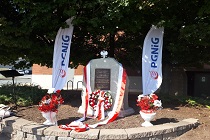 A monument commemorating almost 300 years of Polish emigration to Canada was unveiled in Halifax (Nova Scotia, Canada) on the 16th of September 2018, the year when Poland celebrates a century of independence. This monument is located on the square near the magnificent building of the Museum of Immigration near Pier 21, a very honorary place.
A monument commemorating almost 300 years of Polish emigration to Canada was unveiled in Halifax (Nova Scotia, Canada) on the 16th of September 2018, the year when Poland celebrates a century of independence. This monument is located on the square near the magnificent building of the Museum of Immigration near Pier 21, a very honorary place.
The initiator of the monument was the Honorary Consul of the Republic of Poland in Halifax, Jan Skóra, while the honorary patron of the project was the Polish Ambassador to Canada, Andrzej Kurnicki.
According to the concept of Jan Skóra, the main element of the monument is a slab of rock from Poland. Because Katarzyna Wołkowicz was a member of the six-person Polish Emigration Memorial Committee, the author of this article was asked to select a rock for the monument.
The Godula Sandstone, chosen for the monument, represents a rock formation frequently quarried in the Carpathian region, where the highest proportion of Polish emigrants originated from. Forced by the proverbial Galician poverty, they left their homeland which at that time was divided between the invaders. At the turn of the 20th Century, these journeys were usually one-way. The first stop of the migrants travelling to Canada was in the harbour of Halifax where ships moored at Pier 21. Today, this is a place full of symbolism.
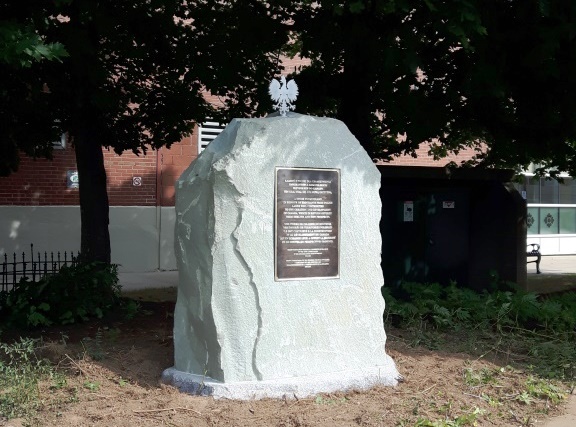
The monument commemorating the history of Polish emigration from Polish lands to Canada before the official unveiling
The journey from the idea of building the monument to its official unveiling was quite long and sometimes winding. However, it is worth revealing how this magnificent block of rock has found its way to the new location, where it is now a frequently photographed object.
The preliminary choice of the rock was consulted with dr Bogusław Bąk from the Carpathian Branch of the Polish Geological Institute (PGI) in Kraków, who expressed very positive opinion about the Godula Sandstone emphasizing its good mechanical qualities as well as decorative features.
Because the Commemoration Committee did not have excessive funds, they tried to find an appropriate block of rock as a donation. Tomasz P. Kasprzyk and Rafał J. Sowula, the owners of the Kamieniołom Barwałd sp. z o.o. with the quarry in Brenna – Głębiec where thickly bedded sandstone is mined, expressed, through Aleksander Kabziński, president of the Polish Association of Aggregate Producers, their generous wish to donate such a block. The choice of the slab was made on the 25th of April 2018 by dr Krystyna Wołkowicz and the author of this article together with Adam Bojda, the foreman supervising the Brenna - Głębiec quarry. After transferring the block to Brenna, it was cut to the required dimensions by the KamTex stonemasonry owned by A. Bojda. There, it was also prepared for its long journey overseas.
The transport of the monument from the Carpathian region to Canada was funded by the Ignacy Łukasiewicz Polish Oil and Gas Foundation. The slab was taken to Gdańsk, where it was fumigated (whatever it is, this process must be carried out before shipping) loaded on a ship, and then through Hamburg and Montreal reached the harbour of Halifax. In Canada, the rock was taken by the stonemasonry of Steven Nelson, Heritage Memorials Ltd. in Windsor (Nova Scotia), who installed the bronze memorial plaque. It was made by Jarosław Pajek, an recognized artist from the Centre of Polish Sculpture in Orońsko.
The plaque was sponsored by the Ministry of Culture and National Heritage of the Republic of Poland. We must appreciate that the Canadian stonemasonry generously installed the monument free of charge and also donated a slab of local light-colour granite as the foundation supporting the sandstone block from Brenna.
We also should mention that the official unveiling was preceded by the resolution of the Parliament of the Nova Scotia Province, recommended by the Nova Scotia Immigration Minister, Lena Metlege Diab. The resolution about the monument was adopted by acclamation!
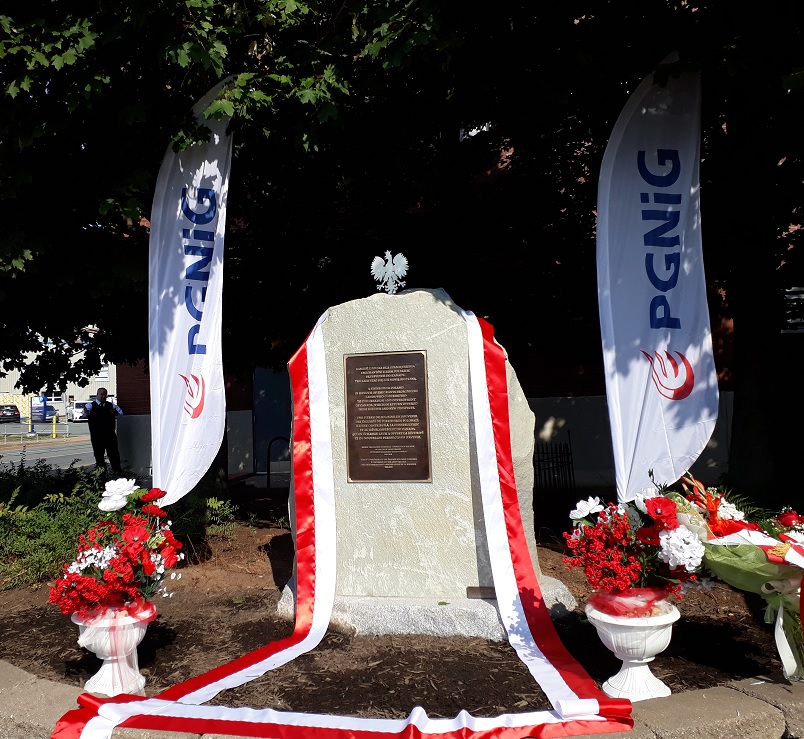
The monument during the unveiling ceremony
The monument unveiling was very solemn, while the master of ceremony was Professor Tom Urbaniak from Cape Breton University. The event was also attended by Andrzej Dera - State Secretary at the Chancellery of the President of Poland Andrzej Duda, Mike Savage - mayor of Halifax, Piotr Woźniak - president of Polish Oil and Gas Company (PGNiG), Tony Ince - Nova Scotia Minister of Public Service Commission, Andy Fillmore - Parliamentary Secretary to the Minister of Canadian Heritage and Multiculturalism, Henryk Sokołowski from the Polish Combatants Association of Canada, representatives of the Polish Ministry of Foreign Affairs, senior officers of the Polish Ministry of National Defence and representatives of Polish diaspora organizations. The management of Harbour Master's Office in Halifax also attended the event. Formally the monument belongs to the Harbour Office, now responsible for its maintenance.
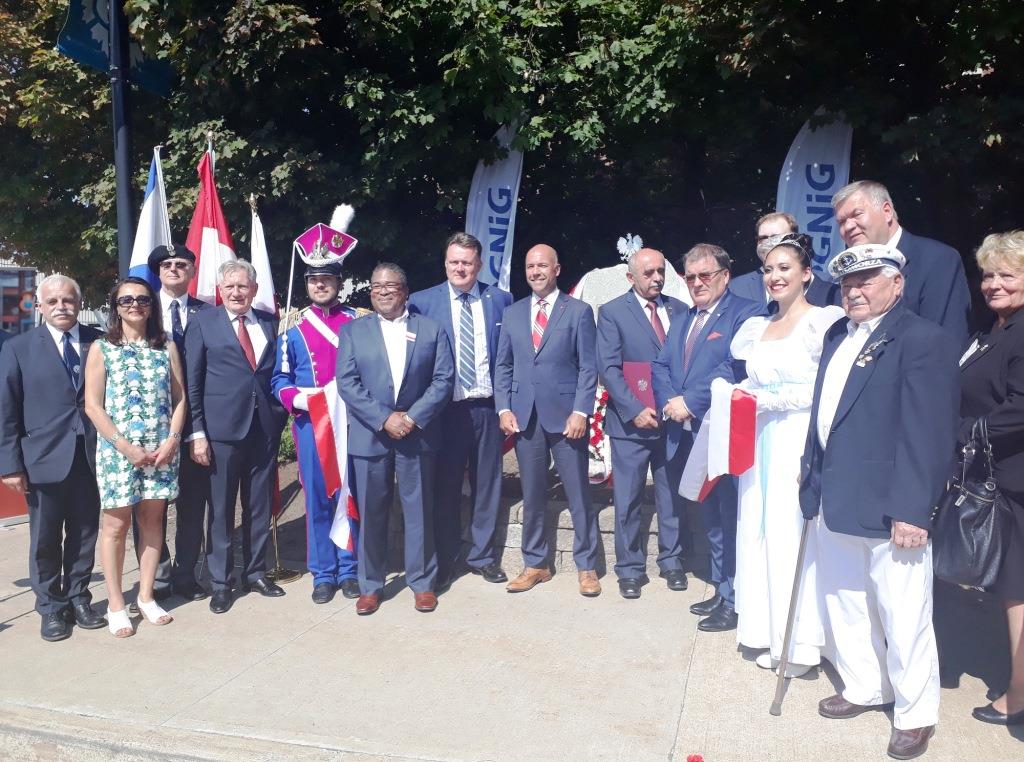
The ceremony was attended by many important guests
In the letter read by the minister Andrzej Dera, the president of the Republic of Poland, Andrzej Duda wrote that he is proud of the scientific and cultural contribution made by Polish people to the Canadian society, who also maintained their heritage. He also stated the need to preserve and develop the closest possible ties with our compatriots around the world, particularly the Polish diaspora in Canada for whom a special place is reserved. The president of the Republic of Poland also expressed his conviction that the monument "will be a lasting trace of Polish presence in Canada and an inspiration for even better cooperation between our countries." Considering the quality of the rock used to create the monument, it is hard to deny that the trace is permanent.
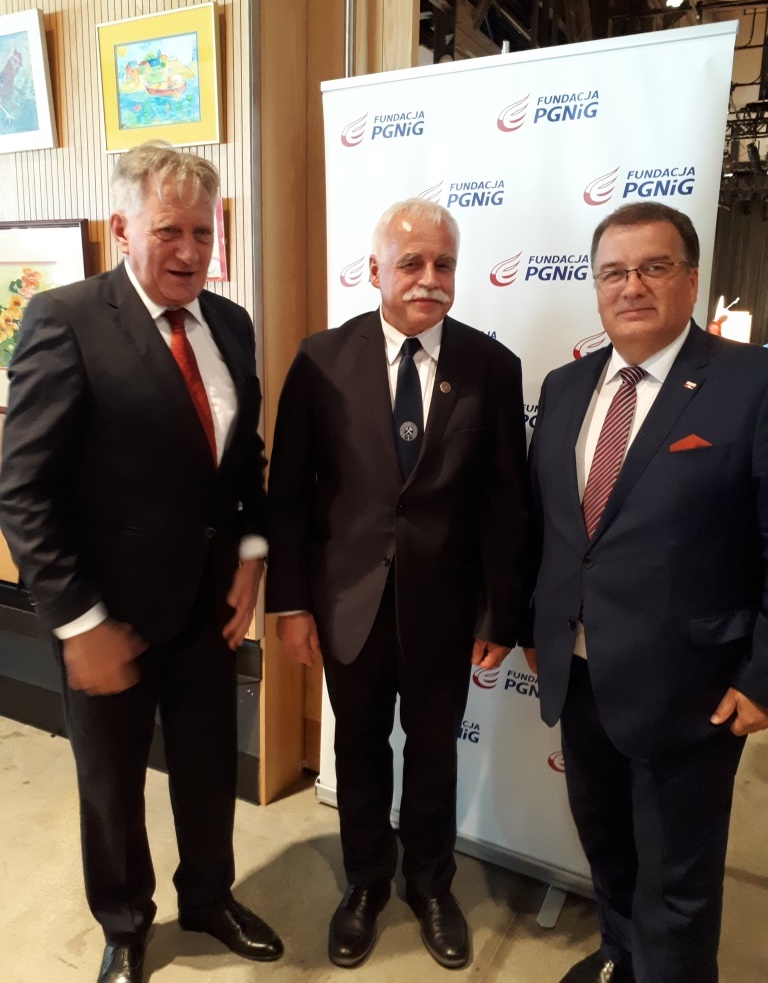
The participants of the ceremony including (from the left) Piotr Woźniak - president of PGNiG SA, dr Stanisław Wołkowicz - professor PGI and Andrzej Dera - State Secretary at the Chancellery of the President of Poland
During the ceremony, the president of PGNiG, Piotr Woźniak delivered a speech, first briefly characterizing the petroleum company managed by him and their international cooperation. He also expressed his satisfaction that PGNiG could contribute to erecting the monument in Halifax, which was possible thanks to good relations with the Polish Geological Institute.
The president emphasized the role of Polish emigrants in developing the Canadian and American economy and culture. This is particularly important in 2018, when Poland celebrates 100 years from getting back its independence, and more importantly when 300 years have passed since the beginning of Polish emigration to Canada. He emphasized that now, when Poland is a free country, cooperation with Canada still continues. The Polish community that lives in Canada actively supports economic ties between both countries.
Other speeches frequently expressed appreciation for the Polish emigrants and their contribution into building Canada and the Canadian society. According to statistics, about one million people in Canada have Polish roots. This is a fair proportion of the country’s population of 36 million. In the Nova Scotia, ten percent of citizens have Polish origins.
The ceremony could not happen without performance of folk groups; there were two groups, i.e. White Eagle Folk Dance Academy from Montreal (Quebec) and Pogoria from Sydney (Cape Breton). Their artistic professionalism as well as the authenticity of their folk costumes deserve the highest appreciation.
Many Polish geologists have worked in Canada, almost every one of us has colleagues who have left to work there as geologists. And the field for exploration is vast! Boundless land of Labrador or Nunavut is reserved for the toughest.
When talking about Polish geologists in Canada, it is necessary to mention Professor Zbigniew Sujkowski (1898–1954) who was employed by the PGI between 1929 and 1942. He was one of the founders of the Polish sedimentary petrography and a pioneer of sedimentology and marine geology. His life was marked with heroic acts of resistance against the occupants. As a 16-year-old, he joined the 1st Polish Cadre Company, in 1915 he was wounded and became a Russian captive. In November 1918, he participated in the disarming of German soldiers in Warsaw, served in the army for two years, and in February 1921 entered the reserves. During the World War II, he fought in the underground. Using the technical and housing facilities of the Institute (during the occupation named as Amt für Bodenforschung) he organized and directed the sabotage and subversion carried out by the Union of Revenge of the Headquarters of the Union of Armed Struggle – Home Army. Due to danger of being discovered in 1942, he resigned from work at the Institute and fully devoted himself to the underground resistance. In the same year, he became the head of the Kedyw Study Office of the Home Army Headquarters. In May 1944, he was transferred to the United Kingdom, where he served as a major in the Chief Commander's Office. After the war, he did not return to Poland, he stayed in England. In 1951, he left for Canada, where he worked as the head of exploration groups in Labrador (Peninsule d'Ungava) and on the western coast of Hudson Bay. In 1953, he became a professor of geology at McMaster University in Hamilton (Ontario). Professor Zbigniew Sujkowski died tragically on the 8th of September 1954 in the Saguenay River, saving his sinking grandson (for more visit website).
May this sedimentary rock of marine origin used for the monument in Halifax remind us of this remarkable geologist, an employee of the same Institute where we also work.
The society of Polish geologists and representatives of the mineral resource industry supported and contributed to creation of this beautiful monument commemorating Polish emigration to Canada expressing appreciation for their effort. The Commemoration Committee for Polish Emigration should be congratulated for the efficient organization of this undertaking as well as spreading the idea of creating the monument. We should also recognise their effort to build a website where readers can learn about the history of the monument and view many photos from the opening ceremony.
Internet website: polonianovascotia.ca/monument
Text: Stanisław Wołkowicz
Photos: Katarzyna Wołkowicz, Joanna Józefiak (PGNiG SA)
Translated by: Tomasz Żuk














 PGI-NRI offer
PGI-NRI offer Mineral resources of Poland
Mineral resources of Poland  Oil and Gas in Poland
Oil and Gas in Poland 




 Subscribe to RSS Feed
Subscribe to RSS Feed